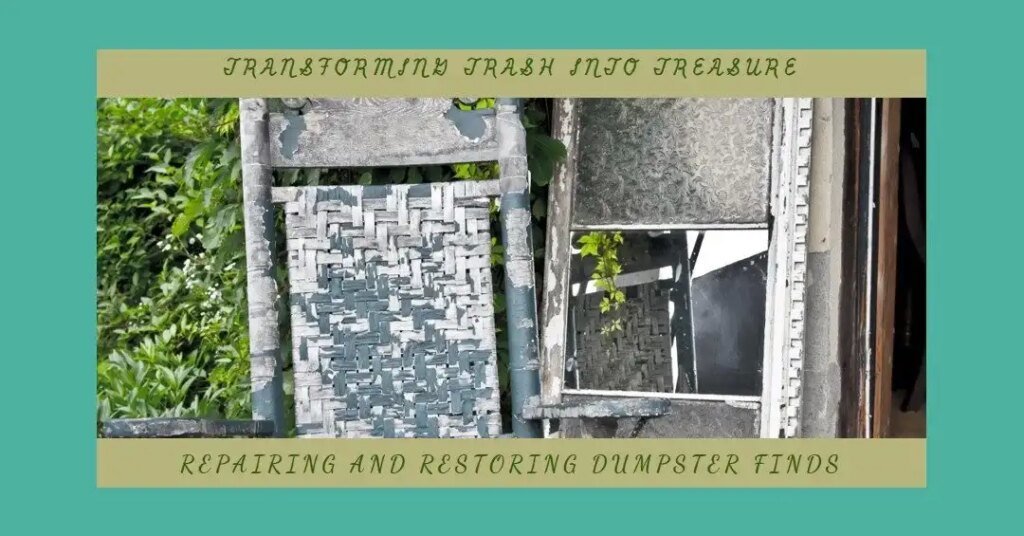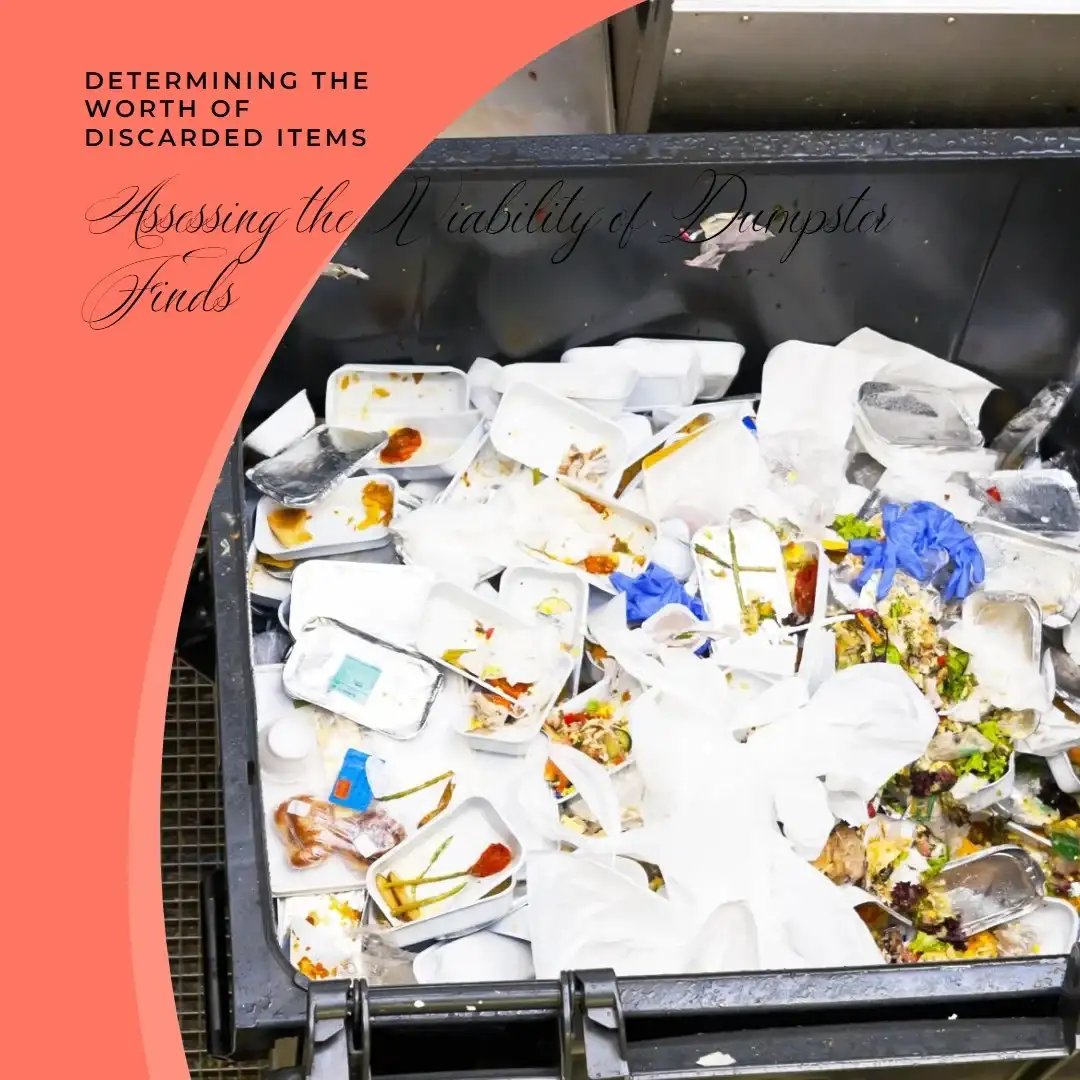When it comes to dumpster diving, finding treasures in the trash can be an exciting and rewarding experience. However, it’s important to assess the items you find to determine their value and usability. There are several factors to consider when evaluating dumpster finds, and the condition of the item is one of the most important.
Factors to Consider When Assessing Dumpster Finds
- Appearance: Look at the overall appearance of the item. Does it appear to be in good condition or heavily damaged?
- Functionality: Test if the item still works as intended. This is especially crucial for electronics or appliances.
- Age: Consider how old the item is. Older items may have sentimental value or be considered vintage.
- Market Value: Research the market value of similar items to get an idea of how much it could be worth.
- Usability: Determine if the item can still serve its purpose. A slightly damaged piece of furniture may be easy to repair and still usable.
The Importance of Condition in Determining Viability
The condition of a dumpster find is key in determining its viability. Even if the item is interesting or valuable, extensive damage or extensive repairs may make it less desirable. Here’s why condition matters:
- Durability: A well-maintained item will last longer and serve you better.
- Resale Value: Items in good condition can be sold for a higher price if you decide not to keep them.
- Safety: Damaged or broken items may pose safety risks, so it’s important to assess their condition before use.
- Enjoyment: If you plan on using the item yourself, it’s important to ensure it’s in good working condition for your own enjoyment.
By considering these factors and assessing the condition of dumpster finds, you can make informed decisions about whether to keep, repair, sell, or dispose of the items you find. Remember, safety should always be a top priority when handling any dumpster finds.
Identifying Valuable Dumpster Finds
When you engage in dumpster diving, it can be really exciting to find hidden treasures amidst the trash. However, it is important to evaluate the items you find to determine their value and usability. There are several factors to consider when assessing dumpster finds, and one of the most crucial factors is the condition of the item.
Determining the Condition of Dumpster Finds
To determine the condition of a dumpster find, there are a few key considerations to keep in mind:
- Appearance: Take a close look at the overall appearance of the item. Does it appear to be in good condition or heavily damaged?
- Functionality: Test if the item still works as intended. This is especially important for electronics or appliances.
- Age: Consider the age of the item. Older items may hold sentimental value or be considered vintage, increasing their desirability.
- Market Value: Research the market value of similar items to get an idea of how much they could be worth.
- Usability: Evaluate if the item can still serve its purpose. For instance, a slightly damaged piece of furniture may be easy to repair and still usable.
By assessing the condition of dumpster finds, you can make informed decisions about whether to keep, repair, sell, or dispose of the items you find.

Assessing the Condition of Dumpster Finds
When you come across a dumpster find, take a careful look at its overall appearance. Does it show signs of physical damage or excessive wear and tear? If an item is heavily damaged, it may not be worth keeping or repairing. However, if it only has minor scratches or cosmetic issues, it could still be salvageable.
Functionality and Performance
For items like electronics or appliances, it’s essential to test their functionality. Make sure they still work as intended before deciding to keep or sell them. Check if all the features are functioning correctly and if any repairs are needed. If an item doesn’t work, it might not be worth the time or effort to fix it.
By paying attention to the physical condition and functionality of dumpster finds, you can determine their potential value and usability. Remember to consider the age and market value of the item as well. With proper evaluation, you can make informed decisions about what to do with your dumpster treasures.
Tools and Techniques for Evaluating Dumpster Finds
When assessing dumpster finds, there are various tools and techniques you can use to evaluate their condition and potential value. Here are some recommendations:
- Visual Inspection: Carefully examine the overall appearance of the item for physical damage and wear. Look for any signs of cracks, dents, or excessive scratches.
- Functionality Test: For electronics or appliances, test their functionality. Check if all the buttons and features are working correctly. If possible, plug them in and ensure they turn on and off smoothly.
- Mechanical Assessment: If the dumpster find is a mechanical device such as a tool or a piece of equipment, assess its operation. Check for any broken or compromised parts that may affect its performance.
Technology and Resources for Evaluation
To aid in the evaluation process, consider utilizing the following technology and resources:
- Online Research: Use the internet to research the item’s brand, model, and specifications. This information can help determine its original value and potential market demand.
- Price Comparison Tools: Utilize online platforms or apps that allow you to compare prices for similar items. This will give you an idea of the item’s resale value and profitability.
- Expert Advice: Consult with experts or enthusiasts in specific fields, such as antiques or electronics, to get their professional opinion on the dumpster find’s value and potential repairs.
By employing these tools and techniques, you can confidently assess the condition and potential value of your dumpster finds. Remember to consider both their physical condition and market demand as you make decisions on whether to keep, repair, or sell these treasures.
Factors Affecting Viability
When evaluating dumpster finds, it’s important to consider their age and rarity. These factors can greatly affect their viability and potential value. Here are some things to keep in mind:
- Age: Older items tend to have more value, especially if they are in good condition. Vintage or antique items may appeal to collectors or enthusiasts.
- Rarity: Items that are rare or hard to find can be highly sought after. They may have a higher resale value due to their uniqueness.
Market Demand and Trends
Understanding the market demand and current trends is crucial when evaluating dumpster finds. Here’s what you should consider:
- Market Demand: Research the demand for similar items in online marketplaces or local stores. This will give you an idea of whether there is a market for the dumpster and how likely it is to sell.
- Trends: Stay updated on current trends and popular items. Certain styles or brands may be in high demand, while others may be outdated or less desirable.
By taking into account the age, rarity, market demand, and trends of your dumpster finds, you can make informed decisions on whether to keep, sell, or repair them. Remember to research, consult experts or enthusiasts, and consider the overall condition and potential profitability of each item.

Repairing and Restoring Dumpster Finds
When it comes to repairing and restoring dumpster finds, there are a few techniques you can try to breathe new life into these discarded treasures. Here are some tips:
- Cleaning: Start by thoroughly cleaning the item to remove dirt, grime, and any potential hazards. Use gentle cleansers and appropriate tools or brushes for different materials.
- Fixing: Assess the damage and determine if you can fix it yourself or if you need professional help. Simple repairs, such as replacing a missing button or fixing a loose screw, can be done with basic tools and materials.
Tips for Safe and Effective Restoration
Restoring dumpster finds can be a fun and rewarding DIY project, but it’s important to prioritize safety and effectiveness. Here are a few tips to keep in mind:
- Do thorough research: Before starting any restoration project, research the proper techniques and materials specific to the item you’re working on. This will ensure that you’re using the correct methods to achieve the best results.
- Take it step by step: Break down the restoration process into manageable steps. Focus on one aspect at a time to avoid becoming overwhelmed or causing further damage.
- Document your progress: Keep a record of your restoration journey by taking pictures throughout the process. This not only allows you to see how far you’ve come but can also be helpful if you decide to sell or showcase your restored item.
By following these techniques for cleaning and fixing, as well as the tips for safe and effective restoration, you can transform dumpster finds into valuable and meaningful possessions. Remember to approach each project with patience and creativity, and don’t hesitate to seek guidance from experts if needed.
Maximizing the Value of Dumpster Finds
When it comes to maximizing the value of dumpster finds, selling and monetizing them can be a great option. Here are some strategies to consider:
- Research the market: Before selling your dumpster finds, research the market to determine the demand and potential value of the item. This will help you set a competitive price and attract potential buyers.
- Choose the right platform: There are various platforms available for selling second-hand or restored items, such as online marketplaces, auctions, or consignment shops. Consider the target audience and the unique features of each platform to maximize your chances of a successful sale.
- Highlight the unique features: When marketing your dumpster finds, focus on the unique aspects or qualities that make them stand out. This could include the history behind the item, any special craftsmanship, or the transformation process it underwent during restoration.
Strategies for Presentation and Marketing
To effectively present and market your dumpster finds, consider the following strategies:
- Professional photography: Invest in high-quality and well-lit photographs of your dumpster finds. Clear and visually appealing images can attract potential buyers and showcase the item’s true potential.
- Detailed descriptions: Provide accurate and detailed descriptions of the item, highlighting its features, condition, and any notable information. This will help potential buyers make an informed decision and build trust in your product.
- Engage with potential buyers: Respond promptly to inquiries and engage with potential buyers in a friendly and informative manner. This can build a positive reputation and increase the chances of a successful sale.
By implementing these strategies for selling, presentation, and marketing, you can maximize the value of your dumpster finds and turn them into profitable ventures. Remember to stay proactive, adaptable, and open to feedback in order to attract the right buyers and achieve your desired results.
Ethics and Legal Considerations
When you come across dumpster finds, it is essential to consider the ethics and legal aspects of your actions. Here are some considerations to keep in mind:
- Respect private property: Make sure to only search and retrieve items from dumpsters that are in public spaces or designated for disposal. Avoid trespassing or taking items from private property without permission.
- Observe local laws and regulations: Familiarize yourself with the specific laws and regulations in your area regarding dumpster diving and the retrieval of discarded items. Make sure to comply with any restrictions or guidelines.
- Refrain from illegal activities: Avoid engaging in any illegal activities while searching for dumpster finds, such as theft or vandalism. Stay within the bounds of the law to maintain a positive reputation and avoid legal consequences.

Proper Disposal and Sustainable Practices
Dispose of any unwanted items responsibly and practice sustainable habits throughout your dumpster diving journey:
- Recycle and donate: If you come across items that you don’t intend to keep or sell, consider recycling them or donating them to a local charity or organization. This ensures that the items are properly utilized and reduces waste.
- Minimize waste: Be mindful of the waste you generate while searching through dumpsters. Avoid excessive packaging or unnecessary waste, and try to repurpose or recycle any materials whenever possible.
- Follow environmental regulations: Adhere to any environmental regulations in your area regarding proper waste disposal and recycling. This helps protect the environment and ensures that you’re acting in a sustainable manner.
By considering the ethics and legal aspects of dumpster diving and adopting sustainable practices, you can enjoy the benefits of finding valuable items while minimizing any negative impact on the environment or community. Remember to always be respectful, responsible, and mindful of your actions.
Conclusion
Dumpster diving can be an exciting and rewarding activity, offering the potential to find valuable items that may have been discarded. From furniture and electronics to clothing and books, you never know what treasures await in dumpsters. However, it’s important to approach this activity with ethical considerations and legal compliance.
If you’re interested in dumpster diving, take the time to familiarize yourself with the laws and regulations in your area. Respect private property and avoid engaging in any illegal activities. Dispose of unwanted items responsibly by recycling or donating them. Minimize waste and follow environmental regulations to act sustainably. By doing so, you can enjoy the thrill of dumpster diving while making a positive impact on the environment and community. Stay safe, be respectful, and happy diving!

Greetings, eco-conscious explorers! I am Arjun Bandari, a seasoned Dumpster Diving enthusiast with over a decade of expertise in uncovering hidden treasures amidst the discarded. My journey into this unconventional lifestyle began in New York, fueled by a passion for sustainability and a desire to challenge the norms of our throwaway culture.
With a bachelor’s in Enviromental Health and Safety, I seamlessly blend academic insights with practical experiences to navigate the world of Dumpster Diving. Over the years, I’ve become a recognized figure in the sustainable living community, sharing my discoveries and insights through workshops, community outreach, and various online platforms.
My commitment to promoting eco-friendly practices has garnered attention from local and regional media, earning me featured spots in publications that highlight the environmental impact of Dumpster Diving. As an advocate for responsible waste management, I have been honored with awards recognizing my contributions to the field.
In addition to my hands-on experiences, I’ve extended my reach through various published works, shedding light on the untapped potential within discarded items. Whether it’s repurposing furniture, salvaging electronics, or sharing practical tips for fellow Dumpster Diving enthusiasts, I am dedicated to inspiring a conscious and sustainable way of living.
Join me on this exciting journey as we redefine the narrative around waste, discover hidden gems, and collectively contribute to a greener, more sustainable future. Together, let’s dive into the world of Dumpster Diving and uncover the beauty beneath the surface of our disposable society.

